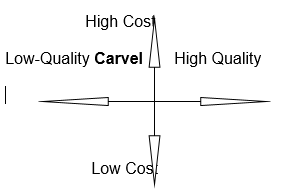Why Carvel entered China in the first place. Please indicate which factors would have been the most important to their decision
Carvel decided to enter China when considered further expansion because this country, its Ministry of Agriculture in particular, already had a joint venture with the company (Gleave 2). Except for that, freezer loan programs and free installation turned out to be extremely beneficial, as the organization had limited financial resources. One more significant factor that influenced the decision was the possibility to cope with competition provided by substantial market share and uniqueness of the product.
The majority of the population was upper and upper-middle class, which coincided with the targeted population. The advantageous condition of residential freezer ownership was also critical. Less influential, but important for the Carvel effect, was made by the quality peculiarities, as similar products were always standard. The country improved its economic growth and had rather low inflation. Literacy rates were high, which was beneficial for the promotion campaign.
Outline what the marketing objective(s), target customer(s), and an overall marketing strategy for Carvel in China should be
Carvel wanted to enter a new market successfully, improve brand awareness and increase sales and profits. The company focused on the widening of the range of offerings. It identified a particular target market and wanted to reach more populations. After Beijing, Carvel planned to start operating in other cities in China.
The company targeted middle and upper-class Chinese professionals, little emperors, and expatriates of both genders. They should have been 25-45 years old. These market segments should have been interested in new products and experiences, which would make them buy Carvel’s products for birthdays, office parties, and other holidays. Potentially, the company wanted to target single mothers and children.
Carvel wished to be profitable, improved its performance, and followed marketing strategy. The manager conducted various researchers and designed plans to get to know more about the country, business, and clients, which allowed to meet customers’ demands.
Develop a marketing plan (i.e., the 4Ps) to improve Carvel’s performance
Product – Carvel divided its product into fountain ice cream, ice cream novelties, and ice cream cakes that can be found with different flavors. The product is unique for China. It is of better quality in comparison to the products of competitors. Carvel wanted to have such a product to be competitive, and it worked.
Place – the product was mainly sold with the help of retail stores and wholesale accounts. Except for the recently targeted country, it could be found in the US, Canada, and Puerto Rico. Moreover, there was a franchise for more than 60 locations. Carvel’s ice cream can be also bought in highway restaurants, supermarkets, and hotels. Thus, the opportunity to reach a diverse market is provided.
Price – psychological approach allowed to consider the way clients perceive the price when defining it. Except for that, the price was based on the type of the product (James 144). Thus, it varied from 78 to 428 Rmb. As a result, Carvel gained 7-8.5 million Rmb. per year.
Promotion – the company had a limited advertising and promotion budget. Its strategy had to be cost-effective and correlate with clients’ beliefs; that is why print media was used, including newspapers, leaflets, and coupon books. Carvel communicated information about it, its products, and its benefits. In case of successful expansion, it was decided to travel further.
Discuss the positioning of Carvel in China
Carvel was positioned as a world-known organization that focused on the wide range of unique products of high-quality that are likely to interest people who are willing to try something new. It emphasized the existence of different flavors and appropriateness of the product for birthdays, office parties, and holidays. Moreover, the targeted population is to have a decent income to be able to purchase this ice-cream.

Works Cited
Gleave, Tom. Developing the Beijing Market. London: Ivey Publishing, 1999. Print.
James, Elijah. Independent Consulting: The Definitive Guide. Victoria: Trafford, 2001. Print.